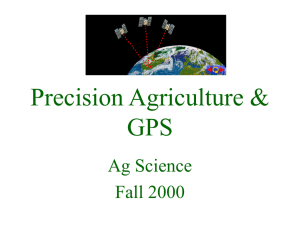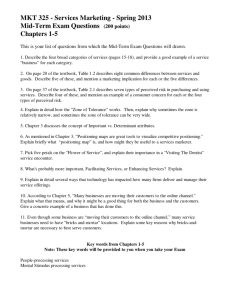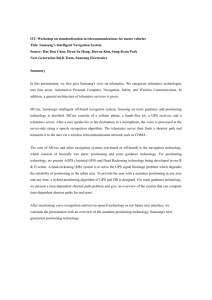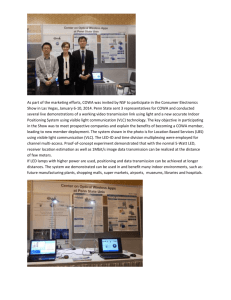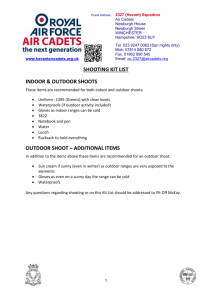A Taxonomy of Indoor and Outdoor Positioning
advertisement
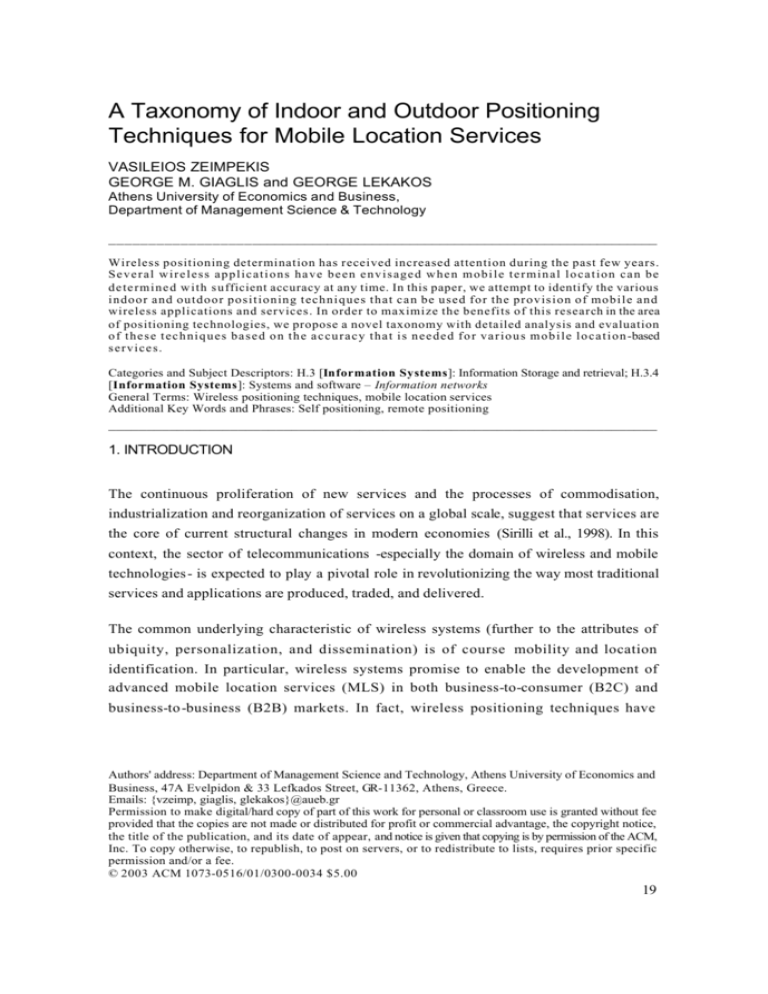
A Taxonomy of Indoor and Outdoor Positioning
Techniques for Mobile Location Services
VASILEIOS ZEIMPEKIS
GEORGE M. GIAGLIS and GEORGE LEKAKOS
Athens University of Economics and Business,
Department of Management Science & Technology
________________________________________________________________________
Wireless positioning determination has received increased attention during the past few years.
Several wireless applications have been envisaged when mobile terminal location can be
determined with sufficient accuracy at any time. In this paper, we attempt to identify the various
indoor and outdoor positioning techniques that can be used for the provision of mobile and
wireless applications and services. In order to maximize the benefits of this research in the area
of positioning technologies, we propose a novel taxonomy with detailed analysis and evaluation
o f t h e s e t e c h n i q u e s b a s e d o n t h e a c c u r a c y t h a t i s n e e d e d f o r v a r i o u s m o b i l e l o c a t i o n -based
services.
Categories and Subject Descriptors: H.3 [Information Systems]: Information Storage and retrieval; H.3.4
[Information Systems]: Systems and software – Information networks
General Terms: Wireless positioning techniques, mobile location services
Additional Key Words and Phrases: Self positioning, remote positioning
________________________________________________________________________
1. INTRODUCTION
The continuous proliferation of new services and the processes of commodisation,
industrialization and reorganization of services on a global scale, suggest that services are
the core of current structural changes in modern economies (Sirilli et al., 1998). In this
context, the sector of telecommunications -especially the domain of wireless and mobile
technologies- is expected to play a pivotal role in revolutionizing the way most traditional
services and applications are produced, traded, and delivered.
The common underlying characteristic of wireless systems (further to the attributes of
ubiquity, personalization, and dissemination) is of course mobility and location
identification. In particular, wireless systems promise to enable the development of
advanced mobile location services (MLS) in both business-to-consumer (B2C) and
business-to -business (B2B) markets. In fact, wireless positioning techniques have
Authors' address: Department of Management Science and Technology, Athens University of Economics and
Business, 47A Evelpidon & 33 Lefkados Street, GR-11362, Athens, Greece.
Emails: {vzeimp, giaglis, glekakos}@aueb.gr
Permission to make digital/hard copy of part of this work for personal or classroom use is granted without fee
provided that the copies are not made or distributed for profit or commercial advantage, the copyright notice,
the title of the publication, and its date of appear, and notice is given that copying is by permission of the ACM,
Inc. To copy otherwise, to republish, to post on servers, or to redistribute to lists, requires prior specific
permission and/or a fee.
© 2003 ACM 1073-0516/01/0300-0034 $5.00
19
attracted much interest and research recently, since they represent a core enabling
technology for a continuously increasing number of mobile business applications
(Mennecke & Strader, 2002). Examples of these applications range from fleet
management to fraud detection and from location-sensitive billing to network
management (Zeimpekis et al., 2002).
However, a key factor that has been identified towards this perspective is the need for
accurate knowledge of mobile terminal position, since the latter facilitates the provision
of mobile value-adding services. Location awareness, which refers to the ability of
mobile hosts to determine the current physical location of wireless access devices (Tseng
et al., 2001) is thus the prerequisite for the visualization of an alluring mobile business
operation.
Although a number of different enabling positioning technologies exist, there is still no
clear classification of the types of indoor and outdoor positioning techniques according to
the accuracy requirements needed by each mobile location service. The research
presented in this paper aims to identify the most promising current and emerging
positioning techniques and to match their characteristics and attributes to the needs and
requirements of various mobile location services (MLS).
The structure of the paper is as follows. Section 2 will present an overview of the most
pertinent technological developments that have enabled the emergence of MLS. This will
be followed by an exploratory discussion of potential mobile applications and services
where location-based techniques can be beneficial. In section 4, technological services
and emerging services will be synthesized into a taxonomy of indoor and outdoor
positioning techniques that is based on the accuracy needed for each mobile location
service. The paper will conclude by discussing limitations as well as future research
challenges that need to be overcome in order to fully exploit the business opportunities
provided by mobile positioning techniques in indoor and outdoor environments.
2. CURRENT AND EMERGING POSITIONING TECHNIQUES
The last few years, positioning (also called location-aware) technologies, have emerged,
enabling the design of applications with the capability to identify a user’s location and
modify their settings, interfaces and functionality accordingly (Pateli et al., 2002).
However, in order to entirely exploit the new types of B2C and B2B applications and
services, research must be carried out in order to match the capabilities of positioning
techniques against the requirements of MLS provision.
This section discusses the most promising current and emerging positioning techniques.
Section 3 will then review the characteristics of major mobile location services, which
20
will then be synthesized in a novel taxonomy outlining what the most suitable methods
for each type of mobile location services are.
Positioning techniques can be implemented in two ways: Self-positioning and remote
positioning. In the first approach (self-positioning), the mobile terminal uses signals,
transmitted by the gateways/antennas (which can be either terrestrial or satellite) to
calculate its own position. More specifically, the positioning receiver makes the
appropriate signal measurements from geographically distributed transmitters and uses
these measurements to determine its position. A self-positioning receiver, therefore,
“knows” where it is and applications collocated with the receiver can use this information
to make positioned-based decisions such as those required for vehicle navigation.
The second technique is called remote positioning. In this case the mobile terminal can be
located by measuring the signals travelling to and from a set of receivers. More
specifically, the receivers which can be installed at one or more locations measure a
signal originating from, or reflecting off, the object to be positioned. These signal
measurements are used to determine the length and/or direction of the individual radio
paths, and then the mobile terminal position is computed from geometric relationships.
2.1 Self positioning techniques
GPS and Assisted GPS (A-GPS): GPS is the worldwide satellite-based radio navigation
system, consisting of 24 satellites, equally spaced in six orbital planes 20,200 kilometres
above the Earth, that transmit two specially coded carrier signals, one for civilian use and
one for military and government use (Djuknic & Richton, 2001). The system’s satellites
transmit navigation messages, which a GPS receiver uses to determine its position. GPS
receivers process the signals to compute position in 3D – latitude, longitude, and altitude
– with an accuracy of 10 meters or less. The main advantage of this technique is that the
GPS system is already in use for many years. However in order to operate properly, GPS
receivers need a clear view of the skies and signals from at least three or four (depending
on the type of information needed) satellites, requirements that exclude operation in
indoor environments. As far as the Assisted-GPS (A-GPS) method is concerned, the
mobile network or a third party service provider can assist the handset by directing it to
look for specific satellites and also by collecting data from the handset to perform
location identification calculations that the handset itself may be unable to perform due to
limited processing power. The A-GPS method can be extremely accurate, ranging from 1
to 10 meters (Giaglis et al., 2002).
Indoor Global Positioning System (Indoor GPS): This system focuses on exploiting the
advantages of GPS for developing a location-sensing system for indoor environments. It
21
should be noted that the GPS signal does not typically work indoors because the signal
strength is too low to penetrate a building (Chen & Kotz, 2000). Nevertheless, indoor
GPS solutions can be applicable to wide space areas where no significant barriers exist.
Indoor GPS takes into account the low power consumption and small size requirements
of wireless access devices, such as mobile phones and handheld computers. The
navigation signal is generated by a number of pseudolites (pseudo-satellites). These are
devices that generate a GPS-like navigation signal. The signal is designed to be similar to
the GPS signal in order to allow pseudolite-compatible receivers to be built with minimal
modifications to existing GPS receivers. As in the GPS system, at least four pseudolites
have to be visible for navigation, unless additional means, such as altitude aiding are used
(Pateli et al., 2002).
Mobile Terminal Positioning over Satellite UMTS (S-UMTS): In contrast with GPS and
A-GPS, the technique that is suggested by Zeimpekis et al. (2002), uses only two
satellites in order to provide positioning services, thus abolishing the need for specific
satellite constellation (such as the GPS constellation) dedicated to positioning services.
The proposed system makes use of a typical Satellite UMTS constellation, which will be
able (through W-CDMA) to provide also other information such as cable TV, satellite
telephony, data transfer, and so on. In order to achieve an acceptable accuracy, the latter
combines three radiolocation methods: time delay, Doppler shift and Doppler rate. The
only drawback of this system is that it can be used only for services that need medium
accuracy (between 100-250m) such as fleet management, targeted congestion avoidance
advice, mobility management, rural and suburban emergency services, as well as local
information news, traffic and localized weather warnings.
2.2 Remote positioning techniques
Cell Identification (Cell-ID): The Cell-ID (or Cell of Origin, COO) method is the basic
technique to provide location services and applications. The method relies on the fact that
mobile networks can identify the approximate position of a mobile handset by knowing
which cell site the device is using at a given time. The main benefit of the technology is
that it is already in use today and can be supported by all mobile handsets. However, the
accuracy of the method is generally low (in the range of 200 meters), depending on cell
size. Generally speaking, the accuracy is higher in densely covered areas (for example,
urban places) and much lower in rural environments (Giaglis et al., 2002).
Direction or Angle of Arrival (AOA): The basic idea is to steer in space a directional
antenna beam until the direction of maximum signal strength or coherent phase is
detected. In terrestrial mobile systems the directivity required to achieve accurate
measurements is obtained by means of antenna arrays (Sakagami et al., 1994). Basically,
22
a single measurement produces a straight-line locus from the base station to the mobile
phone. Another AOA measurement will yield a second straight line, the intersection of
the two lines giving the position fix for this system. Since accuracy is dependent on
distance from transmitter, in satellite mobile systems the antenna directivity necessary for
achieving accurate positioning is quite impracticable with any sort of array that might be
mounted on a satellite. In this case, an indirect estimate can be obtained by measuring the
Doppler shift component in the direction of the mobile terminal produced by the
satellite’s motion.
Time delay: Since electromagnetic waves travel at a constant speed (speed of light) in free
space, the distance between two points can be easily estimated by measuring the time
delay of a radio wave transmitted between them. This method is well suited for satellite
systems and is used universally by them. There are two types of time delay methods that
can be identified: Absolute Timing or Time of Arrival (TOA) and Differential Time of
Arrival (TDOA) or Hyperbolic Technique.
a) Absolute Timing or Time of Arrival (TOA): Positioning information is derived from
the absolute time for a wave to travel between a transmitter and a receiver or vice versa.
This implies that the receiver knows the exact time of transmission. Alternatively, this
approach might involve the measurement of the round-trip time of a signal transmitted
from a source to a destination and then echoed back to the source, giving a result twice
that of the one-way measurement. This does not imply synchronization between the
transmitter and the receiver and is the most common means of measuring propagation
time.
b) Differential Time of Arrival (TDOA) or Hyperbolic Technique: The problem of
having precisely synchronized clocks at transmitter and receiver is solved by using
several transmitters synchronized to a common time base, and measuring time
difference of arrival at the receiver. If in a two dimensional system a line is drawn
joining all points having the same time difference, a hyperbola will be plotted (hence
the name hyperbolic technique). More specifically each TDOA measurement defines a
hyperbolic locus on which the mobile terminal must lie. The intersection of the
hyperbolic loci will define the position of the mobile system.
3. A REVIEW OF FUTURE MOBILE LOCATION-BASED SERVICES
According to Durlacher (2001), the future mBusiness applications can be categorized into
two main categories as illustrated in Table 1. The first one embraces all the business-toconsumer (B2C) applications whereas the second one concentrates onto business-tobusiness (B2B) services.
23
Table 1. A classification of mBusiness applications (Durlacher, 2001)
One of the clearest market applications of MLS can be identified in the consumer
segment and especially in the area of mobile emergency services. The ability of a mobile
user to call for assistance and at the same time automatically reveal their exact location to
the emergency service called (for example, police, ambulance, automotive assistance, and
so on) is considered one of the prime motivators for signing up subscribers to mobile
location services (Hargrave, 2000). Navigation services are also playing a pivotal role in
the development of mobile location-based services and can be based on mobile users’
needs for directions within their current geographical location. Another type of
applications embraces the location-sensitive information services, which mostly refer to
the digital distribution of content to mobile terminal devices based on their location, time
specificity and user behavior. One of the first trial applications of MLS is mobile
advertising, due to its promising revenue potential as well as its direct links to mobile
commerce activities. Furthermore, mobile advertising has gained significant attention
because of its unique attributes, such as personalization (Kalakota & Robinson, 2001),
24
that offer new opportunities to advertisers to place effective and efficient promotions on
mobile environments. Tracking services are also very promising as they can be equally
applicable both to the consumer and the corporate markets. As far as consumers are
concerned, tracking services can be utilized to monitor the exact whereabouts of, for
example, children and elderly people. Similarly, tracking services can be effectively
applied in corporate situations as well. One popular example refers to tracking vehicles so
that companies know where their goods are at any time (mobile Supply Chain
Management or mSCM). Finally, location-sensitive billing is also of significant
importance as it refers to the ability of a mobile location service provider to dynamically
charge users of a particular service depending on their location when using or accessing
the service. For example, mobile network operators may price calls based on the
knowledge of the location of the mobile phone when a call is made.
4. A TAXONOMY OF WIRELESS POSITIONING TECHNIQUES
Based on the various positioning techniques that currently exist and were presented in
section 2, a novel taxonomy of these methods is proposed (Table 2) according to the
accuracy needed by each mobile location-based service that was discussed in section 3.
The table embraces two main categories of future mobile location services: B2C and
B2B. Each channel of services can generate various applications starting from mobile
travel services, automotive assistance, people tracking and continuing with business
applications such as vehicle/fleet management, mobile customer support, and mobile
sales. According to the application environment (whether it is indoor or outdoor
application) and the accuracy requirement (medium or high), we propose a list of the
most appropriate positioning techniques. In addition, there is also technical information
about the type of technology each technique uses to generate the position of the mobile
terminal as well as how the position is calculated (i.e. by using terrestrial, satellite or
device aid). Indoor applications need higher accuracy compared to the outdoor ones that
is why the proposed techniques for indoor environment are based on time delay and
indoor GPS methods that provide high accuracy (from 10 meters to few centimeters). On
the other hand, techniques such as GPS, positioning over S-UMTS and Cell-ID are more
suitable for outdoor environments, where high accuracy is not critical.
5. CONCLUSIONS
The taxonomy of positioning techniques against mobile location services presented in
this paper is based on the accuracy needed for the provision of a series of mobile location
services. More specifically, the main purpose of this classification is to assist
stakeholders at placing themselves and their service offerings within a wider frame that
will help them design better applications, match them with the most suitable underlying
25
technology, and direct them to the most receptive target market base. Furthermore, the
framework focuses on assisting the process of understanding the dynamics of the
emergent phenomenon of mobile location services, with a view to realizing its true added
value. To this end, the framework is a valuable tool for theorists and practitioners alike,
as it can be used both as an extensible analytical instrument and as a deductive actionable
toolkit. However it must be mentioned that although the technology of mobile location
services has been proven in a number of trials, it still remains unclear whether a market
will be created and will take advantage of these technological capabilities. On the other
hand, the MLS field is progressing at an extremely fast pace, therefore the static picture
of the framework may be of limited value in a short time. Future work is continuously
needed to place new technological and service developments within the framework
dimensions so that its sustained usefulness and validity remains. It is also worth
mentioning that the decision on using one technology or another is also based on other
important issues apart from the technical side such as availability, the prevailing legal
situation, and the associated implementation costs (for end-users, network operators, and
device manufacturers alike). To this end, further research work will need to identify and
explore these issues that lie beyond the scope of this paper.
REFERENCES
CHEN, G. AND KOTZ, D. 2000 A Survey of Context-Aware Mobile Computing Research, Dartmouth
Computer Science Technical Report TR2000-381.
DJUKNIC, G. M. AND RICHTON, R.E. 2001, Geolocation and Assisted GPS, IEEE Computer, 34, 2, pp. 123125.
DURLACHER RESEARCH LTD. 2001, UMTS Report, (available online from www.durlacher.com)
GIAGLIS G., KOUROUTHANASIS P., TSAMAKOS A. 2002, Towards a classification network for mobile
location services, In Mennecke, B.E. and Strader, T.J. (Eds.), Mobile Commerce: Technology, Theory, and
Applications, Idea Group Publishing.
HARGRAVE, S. 2000 Mobile Location Services: A Report into the State of the Market, White Paper,
Cambridge Positioning Systems.
KALAKOTA, R. AND ROBINSON, M. 2001, M-Business: The Race to Mobility, McGraw-Hill, New York.
MENNECKE, B.E. AND STRADER, T.J. (EDS.) 2002, Mobile Commerce: Technology, Theory, and
Applications, Idea Group Publishing.
PATELI, A., GIAGLIS, G.M, FOUSKAS, K., KOUROUTHANASSIS P. and TSAMAKOS A., 2002 On the
Potential Use of Mobile Positioning Technologies in Indoor Environments , In the Proceedings of 15th Bled
Electronic Commerce Conference -e-Reality: Constructing the e-Economy, Bled, Slovenia
SAKAGAMI, S., (1994), Vehicle Position Estimates by Multi-beam Antennas in Multi-path Environments,
IEEE Transactions on Vehicular Technologies, 43, 4, pp. 902-908.
SIRILLI, G., EVANGELISTA, R. 1998, Technological innovation in services and manufacturing: results from
Italian surveys, Research Policy 27, pp. 881-899.
TSENG, Y., WU, S., LIAO, W. and CHAO, C. 2001, Location Awareness in Ad Hoc Wireless Mobile
Networks, IEEE Computer, 34, 6, pp. 46-52.
ZEIMPEKIS, V., ALVAREZ, R., TAFAZZOLI, R., and EVANS, B. G. 2002, Impact of constellation design on
Doppler rate based MT positioning for S-UMTS, AIAA 2002-2010, In 20th AIAA International Communication
Satellite Systems Conference, Montreal, Quebec, Canada
26
APPLICATIONS
APPLICATION
ENVIRONMENT
ACCURACY
REQUIREMENT
PROPOSED
LOCATION
METHOD
Emergency calls
Outdoor
Medium to high
TDOA
Business
Automotive assistance
Outdoor
Medium
AOA/TOA
-to-
Travel services
Outdoor
Medium to high
Cell-ID
consumer
m-yellow pages
Banners, Alerts,
Marketing
Outdoor
Medium
Cell-ID
Outdoor
Medium to high
TOA
People tracking
Indoor / Outdoor
High
GPS/Indoor GPS
Indoor routing
Indoor
High
Indoor GPS
Vehicle tracking
Outdoor
Medium
Product tracking
Indoor / Outdoor
Medium to high
Traffic management
Outdoor
Medium
Product replenishment
Indoor
Mobile sales
EXAMPLE
CATEGORY
(B2C)
Triangulation
Triangulation
Cell proximity
Cell proximity
Device from satellite
data
Triangulation
Pseudo- satellite
/Device from satellite
data
Triangulation
over S-UMTS
Device from satellite
data
Triangulation
High
Indoor GPS
Pseudo- satellite
Triangulation
Outdoor
Medium to high
Cell-ID
Terrestrial network
Cell proximity
m- customer support
Outdoor
Medium
GPS/TOA
Terrestrial/Satellite
Network or Device
Triangulation
Field personnel
support
Outdoor / Indoor
Medium to high
Indoor GPS
Pseudo Satellite
Triangulation
business
(B2B)
Terrestrial Network
or Device
Terrestrial Network
or Device
Terrestrial network
TECHNOLOGY
Terrestrial network
Terrestrial Network
or Device
Device from satellite
data/ Pseudo Satellite
Pseudo Satellite
GPS/A-GPS/MT
over S-UMTS
GPS/Indoor GPS
Business
-to-
POSITION
CALCULATION
GPS/A-GPS/MT
Triangulation
Triangulation
Triangulation
Table 2. Appropriate positioning methods for mobile location services
27

